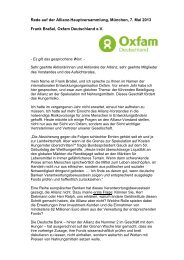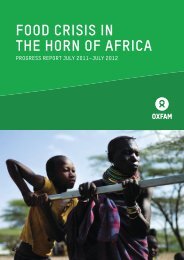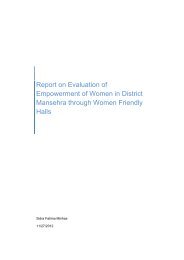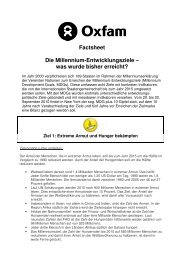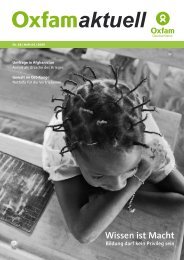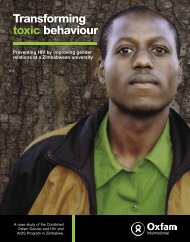No Time to Lose - Oxfam
No Time to Lose - Oxfam
No Time to Lose - Oxfam
You also want an ePaper? Increase the reach of your titles
YUMPU automatically turns print PDFs into web optimized ePapers that Google loves.
‘Unfortunately the coalition<br />
and international<br />
community’s efforts<br />
from 2003-2009 yielded<br />
an Afghan policeman …<br />
who was poorly<br />
equipped and largely<br />
untrained, unable <strong>to</strong><br />
successfully conduct his<br />
duties without significant<br />
Coalition Force<br />
assistance …, and illiterate<br />
with only some<br />
optional literacy training<br />
programs’.<br />
NTM-A Commanding<br />
General Lt Gen William<br />
Caldwell, remarks at the<br />
International ANP<br />
Symposium, 26 January<br />
2011<br />
Germany as the international lead on police training) has also provided<br />
some support, with a focus on civilian policing. 30 EUPOL’s<br />
impact has been limited, however – due primarily <strong>to</strong> the size of the<br />
mission never having been equal <strong>to</strong> its mandate. 31<br />
Until 2009, ISAF’s standard model for the development of the police<br />
force was <strong>to</strong> ‘recruit a new policeman, then assign him <strong>to</strong> a police<br />
district with the intention <strong>to</strong> train him at some future point’ – a strategy<br />
referred <strong>to</strong> as ‘recruit-assign-intend <strong>to</strong> train’. 32 Consequently,<br />
there are now ‘several tens of thousands’ of police who still have not<br />
received even the most basic training. 33 Those who were trained<br />
were put through a program that was heavily focused on military<br />
skills, with just one week out of eight devoted <strong>to</strong> the basic civilian<br />
policing functions of investigating crimes and upholding the rule of<br />
law. Police emerged from the program with little knowledge of policing<br />
ethics, criminal procedures, the Afghan constitution or human<br />
rights law. 34<br />
Some improvements have been made, with training now manda<strong>to</strong>ry<br />
for all new recruits (‘recruit-train-assign’), more than 20,000 police<br />
enrolled in literacy training, and a curriculum that includes a greater<br />
focus on community-based policing. 35 But the basic training has been<br />
shrunk <strong>to</strong> just six weeks – or just three weeks in the case of the ALP. 36<br />
The basic curriculum still ‘mainly covers the use of firearms’, and is<br />
carried out primarily by military officers with no policing background<br />
37 - perhaps a reflection in part of the leading role of the US<br />
Department of Defense (as opposed <strong>to</strong> State) in police reform. Low<br />
literacy rates, the calibre of recruits, high attrition rates and a shortage<br />
of international trainers continue <strong>to</strong> present major challenges.<br />
EUPOL has attempted <strong>to</strong> provide some ongoing men<strong>to</strong>ring after the<br />
initial six-week training, but as one informant recently <strong>to</strong>ld the UK’s<br />
EU Select Committee, this is ‘not working out tremendously well’. 38<br />
The National Police Strategy acknowledges that the ANP ‘can sometimes<br />
behave in a militaristic manner, which can intimidate the population’,<br />
and that current police activities seldom focus on traditional<br />
policing functions. 39 Most Afghans continue <strong>to</strong> view the ANP as<br />
‘lawless armed men, rather than trusted law enforcement officials’. 40<br />
Conduct of the ANSF<br />
At least 2,777 civilians were killed in the conflict in Afghanistan in<br />
2010, the highest since 2001. 41 And despite a perception on the part<br />
of Afghan soldiers and police that the ANSF are not responsible for<br />
civilian casualties, at least 10 per cent of Afghan civilians killed were<br />
killed by their own security forces. 42 But civilian casualty statistics do<br />
not convey the full extent of harm caused <strong>to</strong> the civilian population<br />
by the ANSF, excluding for example children recruited in<strong>to</strong> or sexu-<br />
11




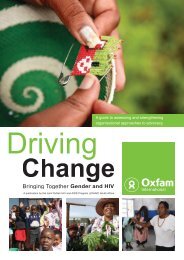

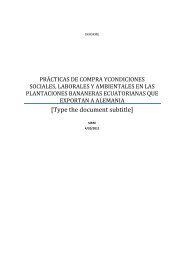
![Download: Faltposter EU-Handelspolitik [PDF 2,17MB] - Germanwatch](https://img.yumpu.com/25095854/1/190x161/download-faltposter-eu-handelspolitik-pdf-217mb-germanwatch.jpg?quality=85)
